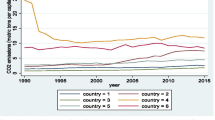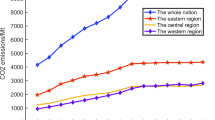Abstract
Economic policy uncertainty (EPU) will affect the external business environment of economic entities, which in turn affects the decision-making of economic entities. Meanwhile, carbon emissions are closely related to the production decisions of microeconomic entities. Thus, studying the relationship between EPU and carbon emissions helps to clarify the impact of institutional factors behind carbon emissions, which is significant for achieving green development. Based on US sector data, we apply a novel parametric test of Granger causality in quantiles to analyze the relationship between EPU and carbon emissions (its growth and uncertainty). We find that there is an outstanding pattern of Granger-causality from the US EPU to the growth of carbon emissions in the tails of the growth distributions of carbon emissions in the industrial sector, residential sector, electric power sector, and transportation sector, except in the commercial sector. That is, carbon emissions are affected by EPU when the growth of carbon emissions is in a higher or lower growth period. Lastly, we find that the US EPU affects carbon emissions uncertainty over the entire conditional distribution for all sectors.



Similar content being viewed by others
References
Abbasi F, Riaz K (2016) CO2 emissions and financial development in an emerging economy: An augmented VAR approach. Energy Policy 90:102–114
Abdouli M, Hammami S (2017) Investigating the causality links between environmental quality, foreign direct investment and economic growth in MENA countries. Int Bus Rev 26(2):264–278
Abel AB, Eberly JC (1993) A unified model of investment under uncertainty. National Bureau of Economic Research.
Al-Mulali U, Tang CF, Ozturek I (2015) Does financial development reduce environmental degradation? Evidence from a panel study of 129 countries. Environ Sci Pollut Res 22(19):14891–14900
Asiedu E (2006) Foreign direct investment in Africa: the role of natural resources, market size, government policy, institutions and political instability. World Econ 29(1):63–77
Badinger H (2010) Output volatility and economic growth. Econ Lett 106(1):15–18
Baker SR, Bloom N, Davis SJ (2016) Measuring economic policy uncertainty. Q J Econ 131(4):1593–1636
Balcilar M, Bekiros S, Gupta R (2017) The role of news-based uncertainty indices in predicting oil markets: a hybrid nonparametric quantile causality method. Empir Econ 53(3):879–889
Balcilar M, Gupta R, Pierdzioch C (2016) Does uncertainty move the gold price? New Evidence from a nonparametric causality-in-quantiles test. Res Policy 49(18):74–80
Balsalobre-Lorente D, Shahbaz M, Roubaud D, Farhani S (2018) How economic growth, renewable electricity and natural resources contribute to CO2 emissions? Energy Policy 113:356–367
Bekhet HA, Othman NS (2017) Impact of urbanization growth on Malaysia CO2 emissions: evidence from the dynamic relationship. J Clean Prod 154:374–388
Bhattacharya U, Hsu PH, Tian X, Xu Y (2017) What affects innovation more: Policy or policy uncertainty? J Financ Quant Anal 52(5):1869–1901
Brogaard J, Detzel AL (2015) The asset pricing implications of government economic policy uncertainty. Social Science Electronic Publishing 61(1): 3-18.
Broock WA, Scheinkman JA, Dechert WD, LeBaron B (1996) A test for independence based on the correlation dimension. Econ Rev 15(3):197–235
Caldara D, Fuentes-Albero C, Gilchrist S, Zakrajšek E (2016) The macroeconomic impact of financial and uncertainty shocks. Eur Econ Rev 88:185–207
Çetin M, Ecevit E (2017) The impact of financial development on carbon emissions under the structural breaks: empirical evidence from Turkish economy. Int J Econ Perspect 11(1):64–78
Charles A, Darné O, Tripier F (2018) Uncertainty and the macroeconomy: evidence from an uncertainty composite indicator. Appl Econ 50(10):1093–1107
Chen Z, Kahn ME, Liu Y, Wang Z (2018) The consequences of spatially differentiated water pollution regulation in China. J Environ Econ Manag 88:468–485
Choudhry T, Papadimitriou FI, Shabi S (2016) Stock market volatility and business cycle: evidence from linear and nonlinear causality tests. J Bank Financ 66:89–101
Connelly, B, L., Certo, S. T., Ireland, R. D., Reutzel, C. R. (2011) Signaling theory: A review and assessment. J Manag 37(1): 39-67.
Delios A, Henisz WJ (2003) Policy uncertainty and the sequence of entry by Japanese firms, 1980–1998. J Int Bus Stud 34(3):227–241
Diaz EM, Molero JC, de Gracia FP (2016) Oil price volatility and stock returns in the G7 economies. Energy Econ 54:417–430
Dibiasi A, Abberger K, Siegenthaler M, Sturm JE (2018) The effects of policy uncertainty on investment: Evidence from the unexpected acceptance of a far-reaching referendum in Switzerland. Eur Econ Rev 104:38–67
Diks C, Panchenko V (2006) A new statistic and practical guidelines for nonparametric Granger causality testing. J Econ Dyn Control 30(9):1647–1669
Dogan E, Turkekul B (2016) CO2 emissions, real output, energy consumption, trade, urbanization and financial development: testing the EKC hypothesis for the USA. Environ Sci Pollut Res 23(2):1203–1213
Esteve V, Tamarit C (2012) Threshold cointegration and nonlinear adjustment between CO2, and income: the environmental Kuznets curve in Spain, 1857–2007. Energy Econ 34(6):2148–2156
Feng L, Li Z, Swenson DL (2017) Trade policy uncertainty and exports: evidence from China's WTO accession. J Int Econ 106:20–36
Garau G, Lecca P, Mandras G (2013) The impact of population ageing on energy use: Evidence from Italy. Econ Model 35:970–980
Granger CW (1969) Investigating causal relations by econometric models and cross-spectral methods. Econometrica 37:424–438
Gray R, Kouhy R, Lavers S (1995) Corporate social and environmental reporting: a review of the literature and a longitudinal study of UK disclosure. Account Audit Account J 8(2):47–77
Gulen H, Ion M (2015) Policy uncertainty and corporate investment. Rev Financ Stud 29(3):523–564
Handley K, Limao N (2015) Trade and investment under policy uncertainty: theory and firm evidence. Am Econ J Econ Pol 7(4):189–222
Işik C, Kasımatı E, Ongan S (2017) Analyzing the causalities between economic growth, financial development, international trade, tourism expenditure and/on the CO2 emissions in Greece. Energy Sources Part B 12(7):665–673
Jiang Y, Zhou Z, Liu C (2018) The impact of public transportation on carbon emissions: a panel quantile analysis based on Chinese provincial data. Environ Sci Pollut Res 26(4):4000–4012
Jones AT, Sackley WH (2016) An uncertain suggestion for gold-pricing models: the effect of economic policy uncertainty on gold prices. J Econ Financ 40(2):367–379
Julio B, Yook Y (2016) Policy uncertainty, irreversibility, and cross-border flows of capital. J Int Econ 103:13–26
Kalamova M, Johnstone N, & Haščič I (2012) Implications of policy uncertainty for innovation in environmental technologies: The case of public R&D budgets. The Dynamics of Environmental and Economic Systems: 99-116.
Katircioğlu ST, Taşpinar N (2017) Testing the moderating role of financial development in an environmental Kuznets curve: empirical evidence from Turkey. Renew Sust Energ Rev 68:572–586
Kellogg R (2014) The effect of uncertainty on investment: evidence from Texas oil drilling. Am Econ Rev 104(6):1698–1734
Lanne M, Liski M (2004) Trends and breaks in per-capita carbon dioxide emissions, 1870–2028. Energy J 25:41–65
Lee J, & Strazicich MC (2003) Minimum Lagrange multiplier unit root test with two structural breaks. REV ECON STAT 85(4): 1082-1089
Lee KH, Min B (2015) Green R&D for eco-innovation and its impact on carbon emissions and firm performance. J Clean Prod 108:534–542
Liddle B, Messinis G (2018) Revisiting carbon Kuznets curves with endogenous breaks modeling: evidence of decoupling and saturation (but few inverted-Us) for individual OECD countries. Empir Econ 54(2):783–798
Ling CH, Ahmed K, Muhamad RB, Shahbaz M (2015) Decomposing the trade-environment nexus for Malaysia: what do the technique, scale, composition, and comparative advantage effect indicate? Environ Sci Pollut Res 22(24):20131–20142
Liu C, Jiang Y, Xie R (2019) Does income inequality facilitate carbon emission reduction in the US? J Clean Prod 217:380–387
Menz T, Welsch H (2012) Population aging and carbon emissions in OECD countries: Accounting for life-cycle and cohort effects. Energy Econ 34(3):842–849
Mutascu M (2018) A time-frequency analysis of trade openness and CO2 emissions in France. Energy Policy 115:443–455
Ozturk I, Acaravci A (2013) The long-run and causal analysis of energy, growth, openness and financial development on carbon emissions in Turkey. Energy Econ 36:262–267
Pastor L, Veronesi P (2012) Uncertainty about government policy and stock prices. J Financ 67:1219–1264
Pastor L, Veronesi P (2013) Political uncertainty and risk premia. J Financ Econ 110:520–545
Phillips PC, & Perron P (1988) Testing for a unit root in time series regression. Biometrika 75(2): 335-346
Richmond AK, Kaufmann RK (2006) Is there a turning point in the relationship between income and energy use and/or carbon emissions? Ecol Econ 56(2):176–189
Rubashkina Y, Galeotti M, Verdolini E (2015) Environmental regulation and competitiveness: empirical evidence on the Porter Hypothesis from European manufacturing sectors. Energy Policy 83:288–300
Shahbaz M, Shahzad SJH, Ahmad N, Alam S (2016) Financial development and environmental quality: the way forward. Energy Policy 98:353–364
Shahzad SJH, Raza N, Balcilar M, Ali S, Shahbaz M (2017) Can economic policy uncertainty and investors sentiment predict commodities returns and volatility. Res Policy 53:208–218
Soytas U, Sari R (2009) Energy consumption, economic growth, and carbon emissions: challenges faced by an EU candidate member. Ecol Econ 68(6):1667–1675
Stern DI (2004) The rise and fall of the environmental Kuznets curve. World Dev 32(8):1419–1439
Troster V (2018) Testing for Granger-causality in quantiles. Econ Rev 37(8):850–866
Tzeremes P (2017) Time-varying causality between energy consumption, CO2 emissions, and economic growth: evidence from US states. Environ Sci Pollut Res 25(12):1–17
Wang Y, Shen N (2016) Environmental regulation and environmental productivity: the case of China. Renew Sust Energ Rev 62:758–766
You WH, Zhu HM, Yu K, Peng C (2015) Democracy, financial openness, and global carbon dioxide emissions: heterogeneity across existing emission levels. World Dev 66:189–207
Zhang C, Tan Z (2016) The relationships between population factors and China’s carbon emissions: does population aging matter. Renew Sust Energ Rev 65:1018–1025
Zhang C, Zhou X (2016) Does foreign direct investment lead to lower CO2 emissions? Evidence from a regional analysis in China. Renew Sust Energ Rev 58:943–951
Zhao X, Sun B (2016) The influence of Chinese environmental regulation on corporation innovation and competitiveness. J Clean Prod 112:1528–1536
Funding
This study was financially supported by the National Natural Science Foundation of China (Nos. 71771082, 71371067, 71431008) and the Hunan Provincial Natural Science Foundation of China (No. 2017JJ1012).
Author information
Authors and Affiliations
Corresponding author
Additional information
Responsible editor: Philippe Garrigues
Publisher’s note
Springer Nature remains neutral with regard to jurisdictional claims in published maps and institutional affiliations.
Rights and permissions
About this article
Cite this article
Jiang, Y., Zhou, Z. & Liu, C. Does economic policy uncertainty matter for carbon emission? Evidence from US sector level data. Environ Sci Pollut Res 26, 24380–24394 (2019). https://doi.org/10.1007/s11356-019-05627-8
Received:
Accepted:
Published:
Issue Date:
DOI: https://doi.org/10.1007/s11356-019-05627-8




